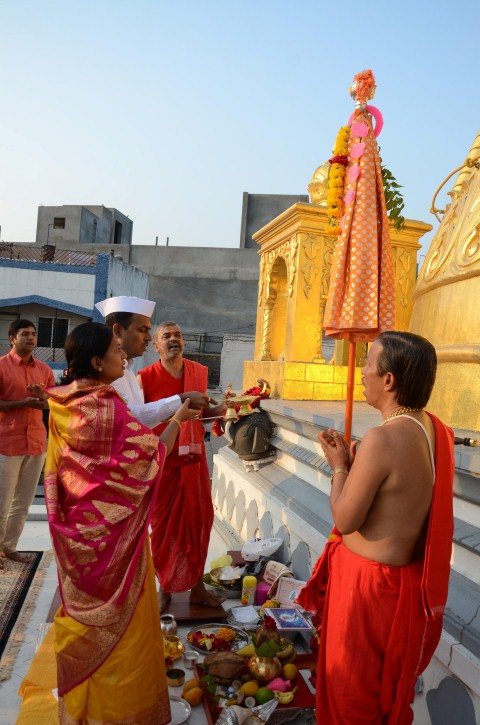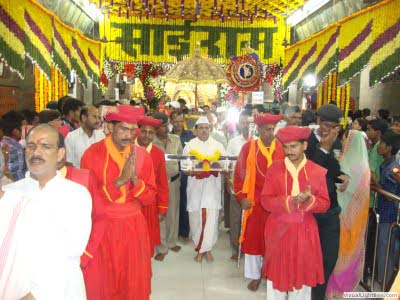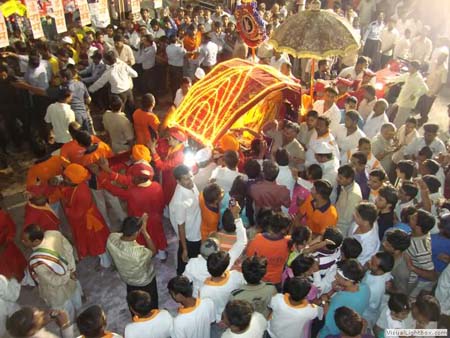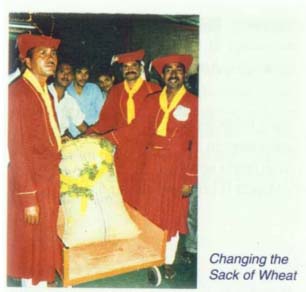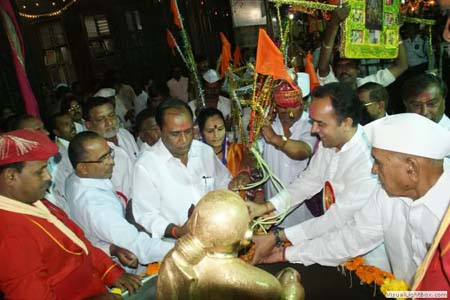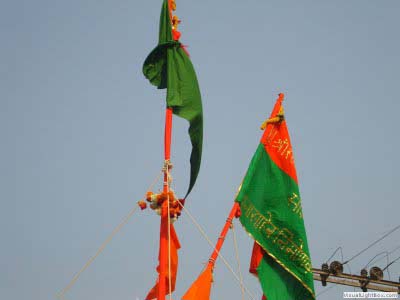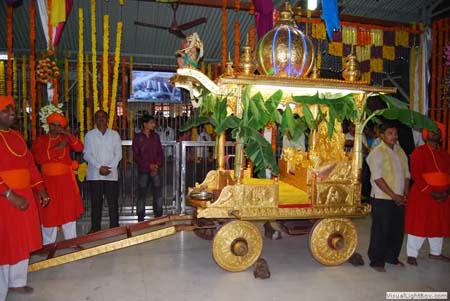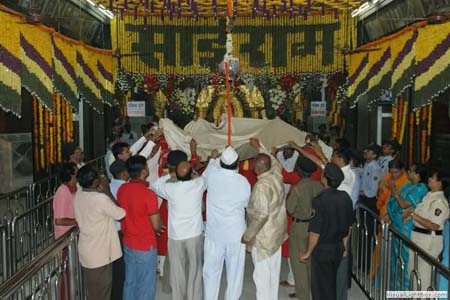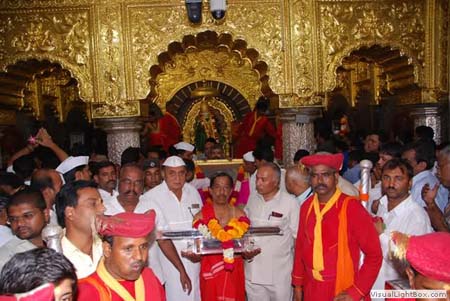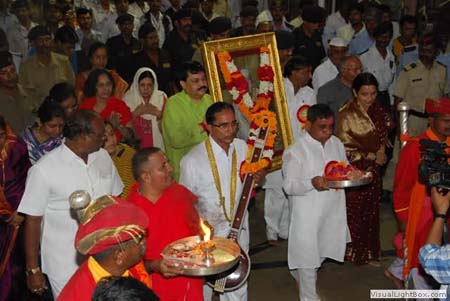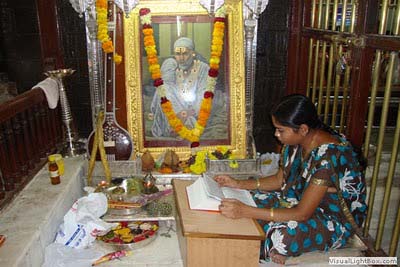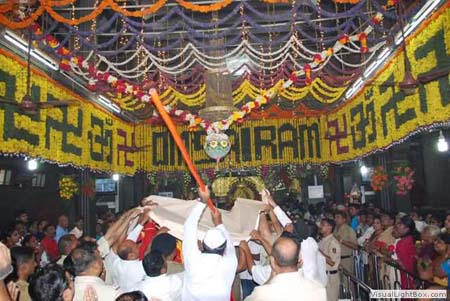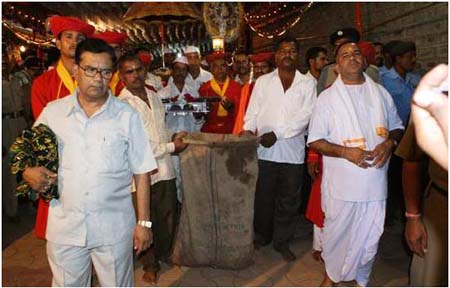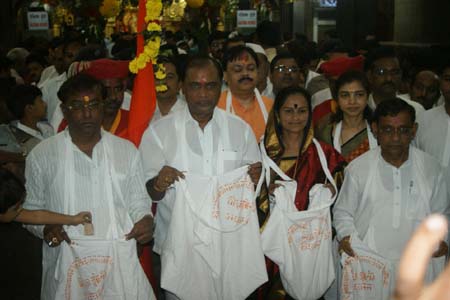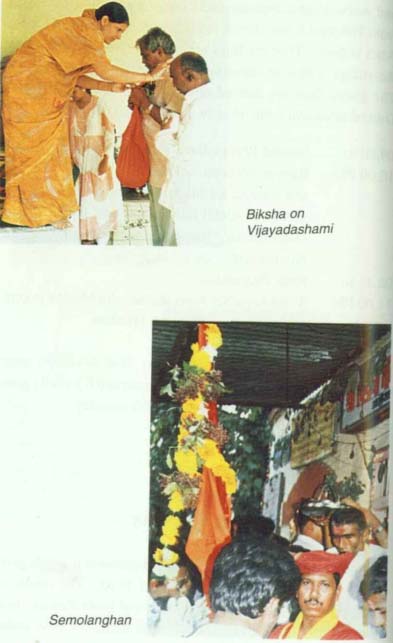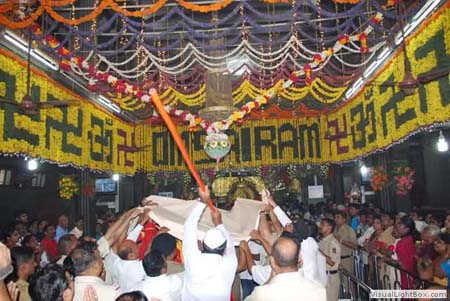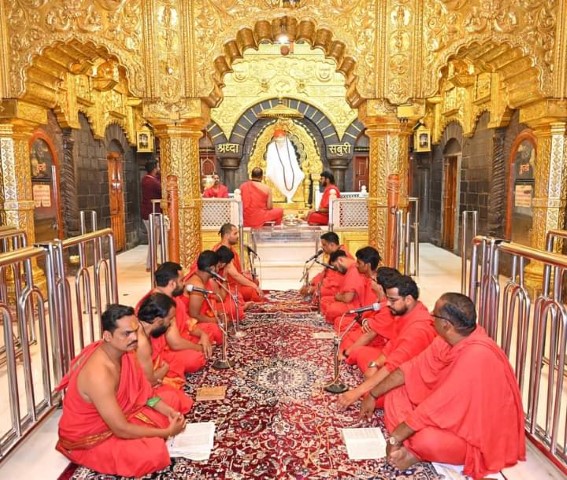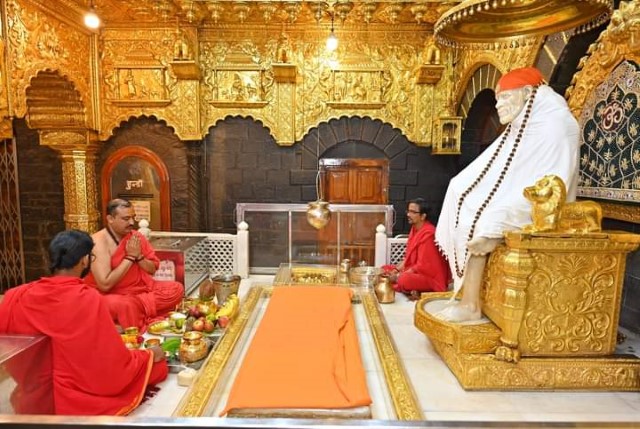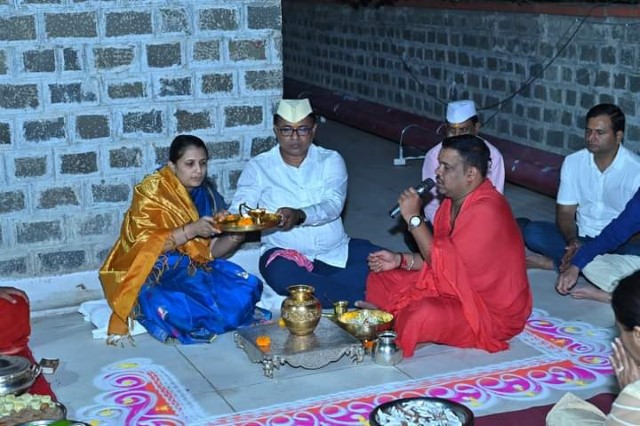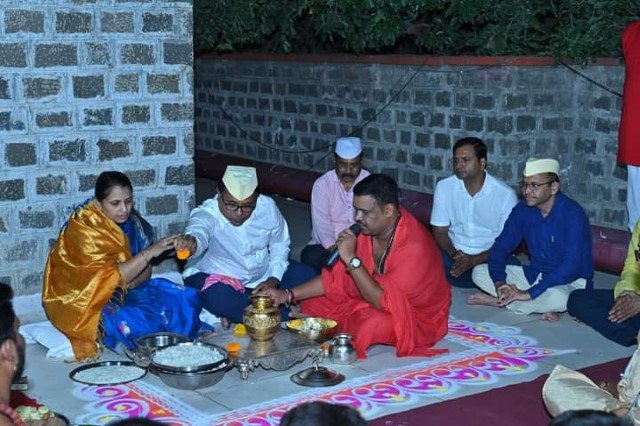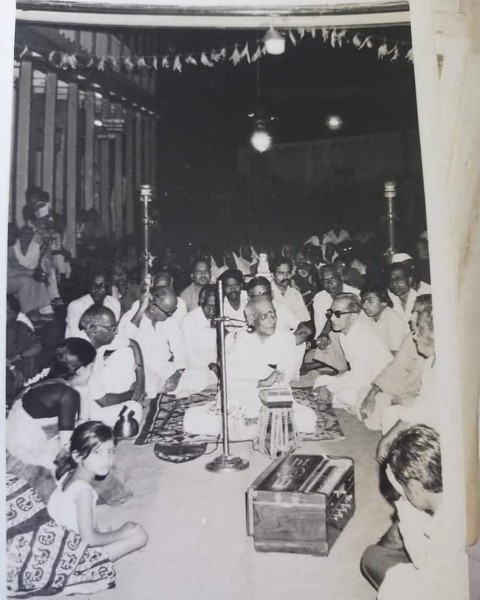FESTIVALS IN SHIRDI
Introduction: All the festivals are celebrated in Shirdi, but the three important festivals are, Ramanavami, Guru Poornima and Vijayadashmi. These are celebrated with great pomp and show. Each is a three-day event and the temples are decorated beautifully with lights, shamianas and look like heaven. In the evenings there are cultural programmes and bhajans by famous artists. There is annadan on the main utsav day of these three festivals. The Prasadalaya serves free meals. The Shirdi Saibaba Sansthan, sanctioned by the district court of Ahmednagar had after mutual deliberations entrusted the management of the Rama Navami Utsav to Das Ganu Maharaj and Tatya Kote. The second major utsav was Guru Poornima and it was managed by Gopalrao Mukund Butti. The sons of the late Gopalrao Butti, managed this Utsav till 1940. From 1941 the Sansthan managed this festival. The descendants of Butti send donations for this festival to date. Baba’s Punyatithi was entrusted to Baba’s devotees outside Shirdi especially from Mumbai. The permanent fund of the Sansthan had been started from the savings of the collections and contributions of the first Bhandara, which was held on the 13th day of Baba’s Mahasamadhi in 1918. The festival of Gokulashtami was entrusted to the villagers of Shirdi headed by Tatya Kote Patil. During all the festivals the Palkhi and Rath were taken in procession through the village. The Rath stopped a while in front of Dixit Wada. There Bhajans and Bharood were performed. Much of these activities are curtailed now by Shirdi Saibaba Sansthan due to the overwhelming crowds. First Day Event: 1. Akhand Parayan reading: A day before the devotees may submit their names for Adhyay reading. After Evening Arati the names are drawn by lottery. These names are announced through the mike and the chapters are allotted. Thus 53 chapters are allotted with a standby list of five names. 'Name lists' are pasted at various places for the convenience of devotees. After Kakad Arati Baba's photo and 'the Pothi' is brought in procession from Samadhi Mandir via: Gurusthan to the Dwarakamai. The Chopdars surpass themselves giving Lalkari at the above temples. In the Dwarakamai the photo is placed in the 'silver mandap' specially made for this occasion, along with the Pothi, After Laghu (small Arati) the reading begins. Since it is Akhand Parayan the Dwarakamai is opened throughout the night. Next morning the Parayan is completed. Again with music and Bhajans the Pothi and the Baba's photo is taken back to the Samadhi Mandir. 2. Palki Procession: The Palki is taken in procession through the village at 8.45 PM. Upon its return to Samadhi Mandir Shej Aarti is performed. Second Day: This is the main Utsav for each festival. Rath procession through the village. No Shej Aarti. Samadhi Mandir is kept open the whole night. Third Day: No Kakad Aarti. Gopal Kaala: Hari Kirtan is started in the morning ending with Gopal Kirtan. Gopal Kaala signifies the end of the festival and ceremonies. A beautifully decorated “Dahi Handi” is hung in the Samadhi Mandir. The honor of breaking it is given to Tatya's descendants. The contents are distributed to the devotees as Prasad. After Gopal Kaala there is Noon Aarti. Gudhi Padwa, The Maharashtra New Year This festival is celebrated on Chaitra Shudh Prathipada i.e., first day of Chaitra Masa (as per the Hindu almanac March-April). Shri Sai Baba Sansthan celebrate this festival as the beginning of Marathi New Year. On this day the “Gudhi” on a post is hoisted on top of the steeple on the Eastern side of Samadhi Mandir. The “Gudhi” is a copper kalash hoisted on a staff. A new cloth is draped on it and has small branches of Neem tied to it. It is garlanded with a flower and “Bathasa Maala” (Bathasa is a cookie made with a concentrated sugar solution). This is hoisted before sunrise. This is a Brahma Dwaja. On the day of Padwa, the idol of Sai Baba is adorned with Gathi-Kade and garments. Gold Necklace and Gathi-Kade are kept throughout the day. Puran Poli is offered to Gudhi at the time of Madhyan Aarti. On the day of Gudhi Padwa, at 5:00 pm, a procession of Shri Saibaba's Chariot is taken out throughout Shirdi village.
Till the 1950’s and 60’s, the Sansthan used to perform abhishek to the Samadhi and then distribute the Puran Poli (a sweet dish) as Mahaprasad. The Samadhi and Baba’s Idol was draped with a beautiful Shawl of Velvet with ornate Zari Work. The idol was garlanded with a “Bathasa Maala”. In the Dwarakamai, an ornate garland of roses made of gold was placed on the portrait. This beautiful garland was donated to the Sansthan by a devotee named Smt.Indira Pendarkar. This unique celebration has been discontinued by the Sansthan. Now the Samadhi and Idol is bathed as usual and the Gudi is hoisted before sunrise. The rath is taken through the village at about 9 p.m. while many years ago the rath used to be taken through the village between 4 p.m. and 5 p.m. (Refer Shiladhi by Dr.Keshav B.Gavankar). Ramanavami, the Festival of Rama’s Birth On Chaitra Masa Shukla Paksha Navami (March-April 9th Day as per the Hindu Almanac) Ramanavami is celebrated. It was in 1911 that Ramanavami was first celebrated in Shirdi. The idea originated from the Urs. It was K.G. Bhishma who conceived of this idea and consulted Kaka Mahajani who liked the idea and readily agreed. Both of them went to Baba and sought permission, Baba gave His consent. Since then Ramanavami is celebrated on a grand scale. It is a three day festival. On the first day, there is Akhand Parayan (continuous reading) of Shri Sai Satcharitra. The devotees can submit their names a day before the festival. In the evening a child is asked to pick up the chits by lottery. Fifty three names are thus chosen and the chapters are assigned, and five names are chosen as standby. After the Dhoop Aarti, these names are announced, and lists are posted at various places. This procedure is followed for all the three major festivals. After Kakad Aarti, the Akhand Parayan commences. The Pothi is brought in procession from the Samadhi Mandir. The procession consists of a devotee (usually a trustee) who carries the sacred Pothi. Alongside him another devotee carries a Veena (a stringed musical instrument). The Veena is symbolic of Saraswati’s Brahma-Veena. Another devotee carries the portrait of Baba. The Kirtankar (who is also the Pujari) sings all the way from the Samadhi Mandir to the Dwarakamai.
The procession commences with Mantra Upachar, Laghu Aarti and Lalkari. The procession comes out of the Samadhi Mandir through the South Gate. Paad Pooja (washing the feet) and Aarti of Camphor are performed by the Iyer family who reside in Shirdi. The procession then goes to the Gurusthan where again Mantra Upachar, Laghu Aarti and Lalkari is performed. The procession then turns right and in front of Dixit Wada Paad Pooja is performed by the Sansthan. It then proceeds through the Maha Dwar past the Maruti Mandir to the Dwarakamai. This entourage is followed by numerous devotees. In the Dwarakamai the area in the verandah next to the railing is decorated with banana trees. A silver shrine is kept to welcome Baba’s portrait and the Pothi. A Laghu Aarti is performed to Baba and the Pothi, then the reading commences. The Dwarakamai is open through the night. Late in the evening there is Palkhi Procession.
The second day is the Main Utsav (festival) Day. There is Kakad Aarti. Then after the completion of the Akhand Parayan, the Pothi is taken in procession to the Samadhi Mandir. There is Mantra Upachar, Laghu Aarti and Lalkari. The Pothi is then taken in procession. It exits the Dwarakamai and passes by the rear of the Samadhi Mandir and enters the Gurusthan where a Laghu Aarti is performed. The entourage then goes towards the main Dwar of the Samadhi Mandir. Just before entering the Samadhi Mandir, Paad Puja is performed to the bearers of the sacred articles by the Sansthan. They then enter the Samadhi Mandir. Thus the entourage would have completed the Pradakshina of the previous day. In the Samadhi Mandir there is Mangal Snan (holy bath of Baba’s Idol). The villagers and numerous devotees go to the Godavari (Kopergaon) and bring water from Godavari for Baba's Holy Bath. Water is also brought from the Ganga and other holy rivers by many zealous devotees. The “Kavadis” (water bearers) are allowed to wash Baba’s Samadhi and Baba's Padukas with the holy water. At about 8 a.m. the changing the sack of Wheat takes place. A new sack of Wheat is brought in procession from the Samadhi Mandir to Dwarakamai. The old sack is taken to Prasadalay and the new sack is placed in the cupboard. This tradition was started by Balaji Newaskar. Now the Sansthan performs this ceremony.
At 12 Noon is the birth of Rama. A cradle is placed in Samadhi Mandir signifying Rama's Birth. Radhakrishna Mai gave a cradle when the first time Ramanavami was celebrated in Shirdi and the tradition continues. Now the Sansthan performs this ceremony. Following this ceremony there is the noon Aarti.
Between 2 p.m. and 4 p.m., the Changing of the Flags takes place. This is described in the Shri Sai Satcharitra Chapter 6 in detail.
Every year two new flags were taken out in procession. Since then this ceremony is performed. The descendants of Damu Anna Rasne supply the embroidered flag, while Nimonkar’s descendants supply the green flag. These flags are kept on Baba’s Samadhi and Aarti is performed to them. Then the Noon Aarti takes place. They are taken to Tukaram Sutar’s house (his surname is Bhalerao and his profession was that of a Sutar or Carpenter). At about 2 p.m.the gheru flags are brought in a procession from Samadhi Mandir to the open area in front of Pilaji Gurav's house. Then the other two flags (The green and embroidered flags) are brought from the Sutar home where they were fixed to a long staff (pole). After Lalkari Laghu Aarti is done. Then all the flags are taken in procession through the village with much dancing and merriment to Dwarakamai. Finally, the two flags (gheru flags – Green and embroidered flags) are fixed atop the Dwarakamai, while the Ochere flag is fixed inside the Dwarakamai.
The Urs and Sandal Procession In 1897 Gopalrao Gund wanted to honor Baba with a special festival, thus the Urs was started accordingly on 16th March 1897 (ref: Shirdi Gazetteer). Urs literally means a wedding with God or uniting the soul with God at death. It is an annual celebration, and the saint’s spiritual power is at its peak at that time. Between 9 p.m. and 10 p.m. the “Sandal Procession” takes place. The descendants of Abdul Baba perform this. It is a beautiful ceremony. A platter with sandalwood scrapings along with incense is taken in procession around the village to the accompaniment of musical instruments. The platter, the incense and gifts to be offered are carried under a canopy. This canopy consists of a “Gailif” or “Chaddar” that is attached to four wooden posts. The Gailif is green in color with golden Kalmas (Kalmas are verses from the holy Quran) inscribed on it. On top of every post is a Panja (a silver replica of a hand). This sandal procession is to venerate Auhlias (Muslim Saints). It is described in chapter 6 of Shri Sai Satcharitra. At the Samadhi Mandir, gifts like a Chaddar (Shawl), fruits and sweets are offered. The procession then goes to Abdul Baba’s Darga and again gifts are offered. The procession ends in the Dwarakamai, where sandalwood mixed with rose water and Attar (a type of perfume) is pasted on the Nimbar with bare hands. In the Evening there is the Rath Procession. The whole right there is Bhajan Sandhya by various invited artists in the Samadhi Mandir. Thousands of devotees participate in this programme and it joyfully goes on till the wee hours of the next day. There is no Shej Arati as Samadhi Mandir is kept open for whole night for Darshan.
The next morning i.e., on the third day, there is no Kakad Aarti. Till 12 Noon there is Kaala Kirtan and then the Gopal Kaala is done. This ceremony is celebrated with joy, merriment and feasting at the end of the festival. A Handi (earthen pot) filled with the ingredients (mixture of curds, Lye- puffed Jvari grain, turmeric powder, cumin seeds, coriander seeds and honey) is hung up and is broken and the contents are distributed. At the auspicious time it is broken and the contents are distributed as Prasad.
Lighting Decoration was done in and around Shirdi Temple Complex for the first time during Shri Ram Navami Festival from 27th March 1950 to 31st March 1950. (ref: Shirdi Gazetteer). Relation between Saibaba and Rama Navami Festival Saibaba celebrated Rama Navami festival right from the early days of his stay in the Dwarakamai. On that day he washed the entire Dwarakamai himself. At about 12 noon he bought a little oil and lit a few lamps. From the rest of the money he bought some Gulal (a dry vermilion powder). Having done this he first put some on the Dhuni Maa and then on his own head. Then he put some on each of the steps leading to the Dwarakamai and in every corner and finally applied some to the entrance door. Later when the devotees started flocking to Shirdi they had Katha and Kirtan in the Sabhamandap followed by the birth of Rama, following which Baba distributed Pedas and Burfi (sweets). (Refer Shiladhi written by Dr.Keshav B.Gavankar). Pooja of the Sadguru or Guru Poornima Saibaba accepted Dakshina and Namaskar (prostrating at his feet) from his devotees. Yet he actively discouraged and forbade ritualistic pooja directed towards him. Instead he asked them to perform pooja to the pillar in front of the Dhuni Maa. Baba sat for hours in front of this pillar leaning his back against it. When the devotees went to the Dwarakamai at about 5 a.m. they found Baba sitting there gazing into the Dhuni Maa. In the year 1908, Tatya Saheb Nulkar, who was a subjudge in Pandarpur, came to stay in Shirdi. Baba asked him to stay in the Chavadi. One day, in the morning Baba told Shama, “Ask Mhatara (old man) to perform pooja to the pillar”. Shama went and told Nulkar (Mhatara) exactly what Baba had said. Both of them discussed the reason for this, but could not come up with an answer. At last they consulted the almanac, and found that it was Vyas Poornima or Guru Poornima Day. But Baba had asked him to perform Pooja to the pillar, and not to him.
Nonetheless they were very happy that at least he had allowed pooja to be performed in the Dwarakamai. Nulkar was performing pooja to the pillar when Shama turned up. Baba said “Why is he performing pooja all by himself? Why can’t you too perform the pooja? Shama replied “I will not perform pooja to this pillar. But if you will allow me to perform pooja to you, I will gladly do so. I will only worship you and not this or any other pillar”. After a lot of debate and discussion, Baba finally agreed.
Dada Kelkar was aware that it was Guru Poornima, so he sent for Tatya who had gone to his farm. Both of them went with pooja materials, and performed Guru Pooja. The rest of the devotees followed suite. They offered fruits, dakshina and vastra (dhotis) to their Guru. The dhoti was of no use to Baba but they got the opportunity to do Guru Pooja that day and they hoped it would continue in the future. Thus the festival of Guru Poornima which was first started on 13th July 1908 (Monday). Now it is a three day function. On the first day there is Akhand Parayan, the second day is the main festival day and it concludes on the third day with Gopal Kaala. (Refer Shiladhi written by Dr.Keshav B.Gavankar). Last Guru Poornima when Sai Baba was alive was celebrated on 23rd July 1918.For the first time procession of Baba's Padukas and Portrait were taken in a chariot (ref: Shirdi Gazetteer).
Guru Poornima is celebrated in the Ashad Masa (June-July). The details of the festival are mentioned below: First Day: Akhand Parayan. Palki procession through the village Dwarakamai is kept open the whole night.
Second Day: Is the main Utsav with Rath procession through the village. There is no Shej Arati as the Samadhi Mandir is open throughout the whole night for Darshan.
Third Day: No Kakad Arati. Gopal Kaala.
Vijayadashmi or Baba’s Aaradhana Vidhi or Baba’s Mahasamadhi Day It was on the 11th Day of the lunar cycle Ekadashi, that Baba’s niryan (Mahasamadhi) took place on 15th October 1918 at about 02.35 PM. In the Muslim month of Moharram it was the ninth day of the ninth month and that night was the “night of slaughter”. The Dashmi had passed into Ekadashi, when Baba’s Seemolanghan occurred. Seemolanghan is crossing the border in procession during Dasara Festival. Four months before Baba's Mahasamadhi He sent Imam Bhai Chota Khan and Kasim (son of Bade Baba) to go to Shamshuddin Mea of Aurangabad. Baba said "Give him (his Rs.250/-. Do there Moulu, Koali and Nyas "). Then they were asked to go to Banne Mea Fakir and garland him and tell him "Navddin, Nav tarik, Allah meane apna dhunia legaya marji Allaki" (Refer Devotees Experience of Saibaba). From time immemorial the Punyatithi of Sadgurus are performed in memory of the compassionate and worthy deeds done by them. So it behoves a devotee to participate in the Aradhana Pooja. This is also an excellent way of performing seva to the Sadguru. The Shirdi Saibaba Sansthan performs the Aradhana Vidhi in the following manner. First Day: Akhand Parayan and Rath procession through the village. Dwarakamai is open throughout the whole night. Second Day: "Biksha" A day before names of the devotees participating in the Biksha are taken by lottery. The devotees assemble in the Samadhi Mandir at 08.00 AM. They are garlanded and gheru jholies are given to them. They are brought in procession to Dwarakamai. After Lalkari they are taken to the five houses that Baba took Biksha from. On the way they accept Biksha from the devotees in return giving some of the contents from their jolies as Baba's prasad.
At about 5 PM the ceremony of Seemolanghan takes place. The word Seemolanghan consist of two words Seema (Border) and Ullanghan (Crossing it) Centuries ago kings practiced this. If they crossed their border first and attacked the neibhbouring kingdoms, it would result in a fewer fatalities and loss of land. For the nine days of Navarathri, the king fasted and performed Devi Pooja and on Dasara (10th Day) they crossed their border and attacked. Lord Rama crossed the border on Dasara day and set out to kill Ravana. It was on this day that Devi Durga killed the demon Mahishasura. The priest from the Samadhi Mandir along with a multitude of devotees performs Seemolanghan. They carry ochre colored Nishan on a pole, this Nishan is garlanded, and Aarti is performed to it at the Dwarakamai. Then in procession they cross the border of Shirdi Village and enter the Khandoba Mandir. There Aarti and Pooja is performed to it. After the pooja is done Shami Leaves (Sona) is exchanged by one and all. The procession returns with the Nishan to the Dwarakamai and the Nishan is hoisted on the grill of the Sabhamandap. Bhajans by various invited artists is held in the Samadhi Mandir the whole night. Samadhi Mandir is open the whole night. Third Day: No Kakad Aarti. Gopal Kaala is performed followed by Noon Aarti.
Kojaagari Poornima The Sharad Poornima or Kojaagari Poornima or Kumar Poornima is a harvest festival celebrated on the full moon day of the Hindulunar month of Ashvin (September–October). It marks the end of monsoon. There is a traditional celebration of the moon and is also called the 'Kaumudi celebration', Kaumudi meaning moonlight.
At night, goddess Lakshmi is worshiped and night vigil is observed. According to a folk-tale, once a king fell on evil days, and was in great financial straits, but then his queen observed this fast and night vigil, and worshiped the goddess of wealth, Laxmi. Consequently, they were blessed by the goddess and they regained their prosperity.
It is also believed that on this day as moon and the earth are very close to each other, the moon rays have certain healing properties of nourishing the body and the soul.
Kaka Mahajani and Dr.Yashwant Galvankar were doing the Kojaagari Poornima festival till the year 1931. In the year 1931 they entrusted the responsibility of conducting Kojaagari Poornima permanently to Dr.Keshav Bhagawant Gawankar. Since then this festival is managed by Gawankar’s family with the cooperation of Shri Sai Baba Sansthan.
As per the advice of his elder brother Pramod Gawankar (eldest son of Dr.Keshav Bhagawant Gavankar), Dr.Sainath K.Gawankar started a registered public trust namely “Dr.Anna Saheb Gawankar Sai Seva Trust, Mumbai” along with family members and some dedicated sai devotees in the year 1991 and is continuing the tradition of conducting Bhajan Sandhya, Annadan and other cultural programmes during the Kojaagari Poornima festival in Shirdi. Shri.Moreshwar Gawankar another elder brother is taking care of this Trust which is situated in Mulund (E), Mumbai. On the night of this festival, Samadhi is worshipped as Lakshmi-Indra on the occasion of Kojagari Poornima at 11:00 pm inside the Samadhi Mandir. Abhishek is done to Baba’s Samadhi. After the pooja, offerings like Coconut water, soaked Pohe, Sugar, Milk are offered. At 12:00 am, midnight the Chandra Pooja (Pooja to the Moon) is performed by seeing th reflection of the image of the Moon in the Milk. The pooja is performed by Chief Executive Officer of Sansthan. The priest goes to the Gopuram, the Samadhi Mandir, and performs the Pooja. He takes sweetened milk or Kheer to be offered as Prasad, which is later distributed. Shej Aarti is performed only after the Sweetened milk or Kheer is offered to the moon and brought back to the Samadhi Mandir at 12:15 am. Dhoodh prasad is distributed after Shej Aarti. Then the Samadhi Mandir is closed. It is believed that whoever is awake throughout the night and perform Naam Sankeertan or remember God their punya will be tripled. Maha Shivaratri Festival (Magha Krishna Trayodashi/Chaturdashi) Maha Shivaratri is celebrated by Shri Sai Baba Sansthan Trust every year. On this day, the photo of Lord Shiva is placed in front of the Idol of Shri Sai Baba. The Photo, the Idol and the Samadhi are adorned with ornaments and sacred leaves of Bhilva Vruksha (Indian Bhel). On this day, after Dhoop Aarti in the evening, from 7:30 pm to 8:30 pm, a programme of Sushravya Kirtan is performed on the stage in front of the Samadhi Mandir. Rudrabhishek is performed at the hands of Honorable Chief Executive Officer at the Mahadev's Pindi in the Gurusthan Temple from 12 noon to 1:30 pm. After that the Gurusthan is closed for darshan. Rangpanchami Festival (Phalguna Krishna Panchami) Rangpanchami festival is celebrated by Shri Sai Baba Sansthan Trust every year. On this day, in the Samadhi Mandir of Shri Sai Baba, saffron enriched water is sprinkled on the idol by the priest. On this day, the Chariot procession is taken throughout Shirdi village at 5 pm. Devotees participate in large numbers and enjoy Rangpanchami Chariot procession. Hanuman Jayanthi (Chaitra Shuddha Poornima) Dakshin Mukhi Hanuman Temple near Samadhi Mandir opens at 4:00 am. On this day, Hanuman's birth is celebrated at sunrise after the abhang. Rudrabhishek is performed in Hanuman Temple. After that, Aarti is performed by offering Dhoop (incense), lamps, offerings (gram dal, sugar, watermelon flakes). The devotees of Hanuman in the village bathe the idol of Hanuman at 6:30 am with Gangajal brought by Kawdi from holy Godavari river. On this day, Hanuman temple is open to the devotees for darshan all over the night. The villagers and bhajan groups perform bhajans. After Kakad Aarti, a photo of Hanuman is placed on the Samadhi plinth (chauthara) inside Samadhi Mandir. Ashada Ekadashi (Ashada Shuddha Ekadashi) This festival is held with utmost fervor at Pandharpur. Devotees may recall here that Shri Sai Baba had given darshan as Vittal (Pandurang) to Das Ganu Maharaj. During Baba's sojourn, this festival was celebrated at the Dwarakamai. The practice of celebrating this festival is still going on even to this day. On this day, Sabudana Kichadi is offered to Shri Sai Baba in Samadhi Mandir during Shirdi Majhe Pandharpur Aarti. At the time of Madhyan Aarti, a photograph of Pandurang Vittal is placed on the Samadhi plinth (chauthara) and flower is offered. On this day, at 9:30 pm, a procession of Shri Sai Baba's Palanquin is taken throughout Shirdi village. The photographs of Shri Sai Baba and Shri Pandurang Vittal are kept inside Palanquin. At the time of Dhoop Aarti, "Yuge Atthavis Vitevari Ubha", the Marathi Aarti of Shri Vittal is sung. Shravana Somavaar According to Dharmashastra, Shravana month is considered very sacred. Lord Shiva is worshipped during this month. On the first Monday of Shravana month, after the Mangal Snan of Shri Sai Baba, the Idol is dressed in white vastra (a piece of cloth), a garland made of Bhilvapatra and Rudraksha garland is also put on Baba's Idol. On this day Khichadi or fruit is offered as Naivedya. A photo of Lord Shiva is placed on Samadhi plinth (chauthara) and ghee and bhagar rice are also offered during Vaishvadeva Pooja at Dwarakamai Temple at 11:30 am. on every Monday of Shravana, Dhoop Aarti is performed at 6:00 pm. Vaishvadeva is performed once again in Dwarakamai Temple before Dhoop Aarti. Ghee and Rice are used as Naivedya for Vaishvadeva at this time of worship. The Maha Naivedya is offered before Dhoop Aarti. As there will be daily Padya Pooja before Aarti, Padya pooja and offering of Pithale-bhakri after Dhoop Aarti is not offered as bhog on this day. At the time of Dhoop Aarti, "Lavthavti Vikrala Brahmandi Mala", the Marathi Aarti of Lord Shiva is sung. Gokulashtami - Shri Krishna Janmotsav - Shravana Bahula Ashtami Gokulashtami festival was celebrated since the sojourn of Sai Baba in Shirdi. This tradition is continued even to this day by Shri Sai Baba Sansthan Trust. Due to fasting on this day, Kichadi, groundnut paste or fruits are offered as Naivedya to Shri Sai Baba. A cradle is placed in Shri Sai Baba Samadhi Mandir. A silver idol of Balakrishna is placed inside the cradle. On this day, Kirtan begins at 10 pm in the Samadhi Mandir. An image of Lord Krishna is placed on the Samadhi plinth (chauthara) during night Kirtan. Exactly at 12:00 am, Lord Krishna's birth anniversary is celebrated and Kirtan is concluded. After the birth ceremony of Lord Krishna, Shej Aarti of Shri Sai Baba takes place. An offering of Shuntiwada (sweet made up of dried ginger and sugar) and groundnut paste are offered at the time of Shej Aarti. After Shej Aarti, Samadhi Mandir is closed. On the second day of Janmotsav, after Shri Sai Baba's Mangal Snan, a Tulasi garland is put on the Samadhi and on the Idol of Shri Sai Baba. Gopalkala Kirtan is performed from 10:00 am to 12:00 noon by a Kirtankar. This is followed by a programme of breaking of Daihandi (the pof of curd). In this way, Gokulashtami festival (Shri Krishna Janmotsav) is celebrated. On the day of Gopalkala, at 9:15 pm, a procession of Shri Sai Baba's Chariot is taken throughout Shirdi village. Narali Poornima (Raksha Bandhan) - Shravana Shuddha Poornima Narali Poornima is celebrated every year on the day of Shravana Shuddha Poornima. On the occasion of Raksha Bandhan, a Rakhi is tied to Shri Sai Baba by Sansthan Priest and then regulalr daily programmes are conducted. The Idol of Shri Sai Baba is adorned with ornaments. Pola (Sharavana Krishna Amavasya) On this day, during the Madhyan Aarti, five earthern bullocks and a cow are worshipped on the Samadhi plinth (chauthara) with Gandha, rice, flowers and Puran Poli is offered as Naivedya. This is followed by regular daily programmes. Ganesh Chaturthi (Bhadrapada Shukla Chaturthi) An image of Lord Ganesh is placed on the Samadhi plinth (chauthara) during the Madhyan Aarti. This image is taken out the next day after Kakad Aarti. Along with the usual offerings, Modak is also offered to Shri Sai Baba. At the beginning of Dhoop Aarti, Ganapati's Marathi Aarti is sung. Anantha Chaturdashi (Bhadrapada Shuddha Poornima) Naraka Chaturdashi (Ashwin Shuddha Chaturdashi) At the time of Mangal Snan, the Idol of Shri Sai Baba and Samadhi are adorned with fragrant Utane (balsam). After that, faral offering (laddu, chivda, chakli etc.,) is offered during Shirdi Majhe Pandharpur Aarti. Lakshmi Pooja (Ashwin Shuddha Amavasya) At the time of Mangal Snan, the Idol and Samadhi of Shri Sai Baba are adorned with fragrant utane (balsam) for all the four daysof Deepavali. After that, faral offering (laddu, chivda, chakli etc.,) is offered during Shirdi Majhe Pandharpur Aarti. From 2:00 pm to 4:30 pm, money packets of Sai devotees are accepted for Lakshmi Pooja and returned back after the Lakshmi Pooja and Dhoop Aarti. Darshan queue is stopped at 4:30 pm at Samadhi Mandir. On the Samadhi plinth (chauthara), an Idol of Lakshmi is placed in a silver lotus mantap decorated with sparkling lights. In front of the Samadhi, silver chowrang aasan (seat) is decorated with Kardali (canna) pillars. Wheat on the chowrang aasan is covered with a silver embossed kalash, tamhan and traditional silver coins in it. An idol of Lakshmi standing in a silver lotus is placed before the idol of Shri Sai Baba. Shankh (conch shell), holy bells and betel leaves are placed in front of him. At 5:00 pm, Lakshmi Pooja begins at the hands of Chief Executive Officer of Shri Sai Baba Sansthan in the space in front of the Samadhi Mandir. On this occasion, gold ornaments are placed on the idol of Shri Sai Baba. After Lakshmi Pooja, Shri Sai Baba's Dhoop Aarti begins. The offerings include incense, corriander, jaggery, lahya, pedha and faral. At the time of Dhoop Aarti, "Sukhkarta Dukhharta Warta Vignachi" the Marathi Aarti of Lord Ganesh and "Durge Durghat Bhari Tuj Veen Sansari" the Marathi Aarti of Shri Durga are sung. Deepavali Bali Padyami - Kartika Shuddha Pratipada Distribution of Rava Laddus is offered to Sai devotees in the form of Prasada after the Marathi Aarti "Shirdi Majhe Pandharpur". Kartika Ekadashi (Kartika Shuddha Ekadashi) Kartika Shuddha Ekadashi is also known as Prabodhini Ekadashi. This is the Prabodh Utsav of Lord Vishnu. Chaturmasya of Gods ends on this Ekadashi day. There is a belief that Gods wake up on this day. After the Mangal Snan of Shri Sai Baba, the Idol of Shri Sai Baba is decorated with Wreathe and a garland of Tulasi. Then Sabudana Khichadi is offered during Shirdi Majhe Pandharpur Aarti. An image of Pandurang (Vittal) is placed on the Samadhi plinth (chauthara) at 12:00 noon during the Madhyan Aarti. On the Kartika Ekadashi at 9:15 pm, a procession of Shri Sai Baba's Palanquin is taken throughout Shirdi village. The idols of Lord Pandurang (vittal) and Shri Sai Baba are placed inside the Palanquin. At the time of Dhoop Aarti, "Yuge Atthavis Vitevari Ubha" the Marathi aarti of Shri Vittal is sung. Tulasi Vivaha (Kartika Shuddha Dwadashi) Every year, Tulasi Vivaha Ceremony is celebrated inside Dwarakamai Temple. In the evening, after Dhoop Aarti, the Tulasi Vivah is celebrated at the Dwarakamai Temple on Kartika Shuddha Dwadashi day. Chief Executive Officer and his wife will perform the Vivah Ceremony. During this time, the entire Vivaha Ceremony is religiously performed. Datta Jayanthi Festival (Margashira Suddha Poornima) After the Mangal Snan of Shri Sai Baba, the Idol of Shri Sai Baba is decorated with Wreathe and a garland of Tulasi. Then Sabudana Khichadi is offered during Shirdi Majhe Pandharpur Aarti. Madhyan Aarti is held at 12:00 noon. At this time, a portrait of Shri Guru Dattatreya is placed on the Samadhi plinth (chauthara). In the evening, from 4:00 pm to 6:00 pm, Kirtan of Shri Dattatreya Janma Utsava is performed. Aarti to Shri Dattatreya is sung during Dhoop Aarti. On this day, an Aarti programme is organized at the Dattatreya Temple inside Lendi Baugh. On the day of Datta Jayanthi, a Chariot procession is taken out throughout Shirdi village at 9:15 pm. The photographs of Lord Dattatreya and Shri Sai Baba are placed inside the Chariot. At the time of Dhoop Aarti, "Trigunatmak Trimurti Shri Datta Ha Jana" the Marathi Aarti of Shri Dattatreya is sung. (Source: Ambrosia in Shirdi & Baba’s Gurukul by Vinny Chitluri, Shri Sai Baba Sansthan Trust, Shirdi. Photo Courtesy: SSST, Shirdi & Smt.Suma Shekar, Bangalore) |
